How Much Broadband Speed Do I Need? Find Your Perfect Plan
How Much Broadband Speed Do I Need? Find Your Perfect Plan

For most of us in the UK, a broadband speed somewhere between 30 and 100 Mbps is the sweet spot. It's usually enough for everyday streaming, browsing, and working from home without wanting to throw your laptop out of the window.
Of course, the right number for you depends entirely on how many people and devices are fighting for that connection at any given time. Picking the right speed is important, but finding a provider who can actually deliver it reliably is the real game-changer. This guide will show you how to find the perfect speed and, more importantly, how to secure the best deal using our affiliate postcode checker.
Finding Your Ideal Broadband Speed

Trying to figure out how much broadband speed you really need can feel like a bit of a guessing game. It doesn't have to be.
The easiest way to think about it is like a motorway for your data. The more lanes you have—measured in Megabits per second (Mbps)—the more digital traffic can flow without causing a jam.
Imagine the chaos when your family tries to stream a 4K film, join a video call, and play an online game all at once. On a narrow, two-lane road (a slow connection), everything grinds to a halt. You get buffering, dropped calls, and infuriating lag. A wider, multi-lane motorway (a faster connection) handles all that traffic with room to spare.
Matching Speeds to Your Household
The trick is to match the number of lanes to the amount of traffic your household actually creates. A solo user who mainly sticks to browsing and emails can cruise along just fine on a basic plan. But a family of four with multiple smart devices needs a whole lot more bandwidth to keep things running smoothly.
Think about which of these scenarios sounds most like your home:
- Light Use (1-2 People): If you're mainly browsing, scrolling through social media, and streaming HD video on one device, a speed around 30 Mbps should do the trick.
- Medium Use (2-4 People): For households that regularly stream in 4K, work from home with video calls, and have a few smart gadgets running, aiming for 50-100 Mbps is a smart move.
- Heavy Use (4+ People or Tech-Heavy Homes): Is your house full of competitive gamers, 4K streaming addicts, and countless connected devices? You'll want speeds of 100 Mbps or higher to make sure everyone has a seamless experience.
The most common mistake people make is either paying a fortune for speed they’ll never use or, worse, underestimating their needs and suffering through a painfully slow connection. You want to find that perfect balance of performance and price.
Ultimately, the 'best' speed is simply the one that supports your digital life without constant interruptions. Before you can lock in a speed, you need to know which providers even operate in your area.
The smartest first move is to see what’s actually available at your address. This is the quickest way to get a personalised list of deals, so you’re only comparing plans you can actually get. We recommend using our affiliate postcode checker to instantly see the best options for your home.
Quick Guide to UK Broadband Speeds
To make it even simpler, we've put together a quick table to help you find your ideal broadband speed based on what your household gets up to online.
This table should give you a solid starting point. Just remember to account for everyone in your home—and all their gadgets—when making your decision.
Understanding Mbps, Uploads, and Latency

To really get to the bottom of "how much broadband speed do I need?", you need to look past the big, flashy number on the advert. The true quality of your internet connection is a team effort, a trio of factors working together: download speed, upload speed, and latency. Getting your head around all three is the secret to picking a plan that won't leave you pulling your hair out.
Download vs Upload: What’s The Difference?
Most providers love to shout about their download speeds, and for good reason. But in our modern, connected lives, upload speeds are just as vital.
Think of it like a trip to the local library.
Download speed is how quickly you can grab a massive stack of books off the shelves and get them home. It’s all about pulling data from the internet to you. This is what you rely on for:
- Streaming films and TV shows in crisp 4K.
- Downloading hefty game files or software updates.
- Just browsing the web and loading up image-heavy sites.
Upload speed, on the other hand, is how fast you can return all those books. It dictates how quickly you can send information from your devices to the internet. This is make-or-break for:
- Video calls on Zoom or Teams, where you're constantly sending your video stream out.
- Backing up large files to cloud storage like Google Drive or Dropbox.
- Live-streaming your gaming triumphs on a platform like Twitch.
For years, broadband plans have been 'asymmetric', meaning they give you much faster downloads than uploads. That's fine for many, but if you work from home, create content, or have a family of avid gamers, a slow upload speed becomes a serious bottleneck.
A classic sign of poor upload speed is having a "fast" 100 Mbps plan, yet still suffering through glitchy, frozen video calls. This usually happens because your upload speed is a tiny fraction of that headline figure—sometimes as low as 10 Mbps—which just can't keep up with a smooth, high-quality video feed.
Why Latency Is The Secret Ingredient
The third, often overlooked, piece of the puzzle is latency, which you might also hear called 'ping'. If speed is the width of the motorway, latency is how fast your car reacts to you hitting the accelerator. It’s the time it takes for a signal to zip from your computer to a server and back again, measured in milliseconds (ms).
Low latency is absolutely critical for anything that needs instant feedback. For a competitive online gamer, high latency (or a high 'ping') means a frustrating delay between pressing a button and seeing your character react on-screen—a guaranteed recipe for defeat. It’s also the key to lag-free video calls, making conversations feel natural and seamless instead of disjointed and awkward.
For most online activities, a latency below 50ms is great. If you’re a serious gamer, you’ll want to aim for under 20ms.
The goal is to find a plan that strikes the right balance between all three—download, upload, and latency. The catch is that not all providers deliver on all fronts. This is where our affiliate comparison tool becomes invaluable. It lets you see the real-world performance specs for different plans in your area, so you can find a provider that truly offers the balanced, reliable connection you need. By using our recommended postcode checker, you can cut through the marketing fluff and compare the plans that will actually perform for you.
Matching Your Speed to Your Digital Lifestyle
Picking the right broadband speed is a bit like choosing the right tool for a job. You wouldn't use a sledgehammer to hang a picture, and you wouldn't try building a deck with a tiny screwdriver. Your household's online habits are unique, and your broadband plan should match them perfectly. This avoids the two biggest pitfalls: overpaying for power you simply don't use, or suffering through frustratingly laggy internet.
So, how do you figure out the magic number? The first step is to get a handle on your own 'digital lifestyle'. Once you know which type of user profile best describes your home, you can find a plan that just feels right.
This diagram breaks it down nicely. Your speed needs really boil down to three things: the number of people using the internet, how many gadgets are connected, and what you’re actually doing online.

The key takeaway here is that all these factors are connected. Every time you add another person or another smart device, you're putting more strain on your connection. That’s when faster speeds stop being a luxury and start becoming a necessity.
Find Your Broadband Persona
Let's look at some common UK household types. See which one sounds most like your place to get a much clearer idea of the speed you should be aiming for.
The Solo Streamer: You might live alone or with a partner, and your internet use is pretty straightforward. You're streaming films in HD, scrolling through social media, managing emails, and maybe hopping on the occasional video call. A solid, reliable connection in the 30-50 Mbps range will be your best friend, giving you smooth performance without costing a fortune.
The Busy Family: Your home is a constant hub of digital activity. It's not unusual for multiple people to be online at once—someone’s watching Netflix in 4K, another is on a Zoom class for school, and a third is deep in an online gaming battle. To avoid these digital traffic jams, you need a much beefier plan, something around 100 Mbps or higher.
The Competitive Gamer: For you, victory is measured in milliseconds. You need ultra-low latency (ping) and enough bandwidth to download massive game updates without waiting forever, all while streaming your gameplay on Twitch. Here, a high upload speed is just as critical as download. You should be looking at fibre plans that offer at least 150 Mbps, ideally with symmetric speeds (where upload and download are the same).
The Remote Professional: Your home office is your command centre. You're completely dependent on flawless video calls, transferring chunky work files, and being connected to cloud services all day long. An internet interruption isn't just a minor annoyance; it's a productivity disaster. A stable 50-100 Mbps plan is the absolute minimum to keep your workday running without a hitch.
Choosing a plan that fits your persona is the surest way to get it right. It means you’ve got the power when you need it, but you're not paying for a load of extra capacity that sits idle most of the time.
Finding a provider who can deliver the right package for your lifestyle is the final, crucial step. Thankfully, broadband availability has improved massively across the UK. Government figures showed that by 2020, over 93% of homes in every nation had access to standard fibre. Even so, getting the right speed can still feel like a postcode lottery for some. You can explore more about the UK's broadband availability journey to see how network developments impact your choices.
The best way to cut through the noise and find a cost-effective plan that’s genuinely right for you is to see what’s available at your specific address. Using our affiliate checker gives you an instant, personalised list of the best deals from providers who can service your home.
How Your Location Impacts Your Broadband Options

Ever wondered why your mate in the next town over gets lightning-fast gigabit internet while you’re stuck in the slow lane? The answer nearly always comes down to one thing: geography. Before you even ask, "how much broadband speed do I need?", the real question you should be asking is, "how much can I actually get?".
Your physical address is the single biggest decider of your broadband options. It's a simple fact that the UK has a noticeable speed gap between its busy urban centres and more remote, rural areas. This isn't a problem with your computer or your Wi-Fi router; it’s a direct result of the physical cables—or lack thereof—running under your street.
Someone living in a city like Manchester or Belfast might have a dozen different ultrafast fibre providers fighting for their business. Meanwhile, someone in a small village could find their choice is limited to just a couple of providers, often running on much slower, older copper lines. It’s a familiar story all across the country.
The Urban-Rural Speed Divide
This difference in available technology creates a very real gap in performance. Data consistently shows this divide, with city dwellers enjoying much higher average speeds. For example, back in March 2022, the median 24-hour download speed in UK urban areas was 16.2 Mbps—more than double the rural average of just 6.0 Mbps. It just goes to show how wildly different the broadband experience can be depending on your postcode.
This gap proves that the "best" broadband deal isn't a one-size-fits-all solution; it's completely dependent on what’s available at your front door. You could spend hours researching the perfect 500 Mbps plan, only to find out the provider doesn't even serve your area.
The most critical first step you can take is to check what's actually available at your specific postcode. This simple action cuts through all the noise and saves you from the immense frustration of shopping for plans you can never get.
Your Essential First Step: The Postcode Check
Don't waste your time browsing plans that aren't meant for you. The only way to get an accurate, personalised list of the providers and speeds you can genuinely sign up for is by using a postcode checker.
It’s the smartest and most efficient way to kick off your search. Think of it as an essential, non-negotiable tool that instantly reveals every available option. It will show you the big players and even smaller, local full-fibre providers you might not have heard of, like those we cover in our BRSK review.
This isn’t just about saving time; it's about making an informed decision based on real-world availability. Once you have your list, you can confidently compare plans and find that perfect balance of speed and price for your home. By using our affiliate link for the postcode checker, you support us in creating more helpful content like this.
Securing the Best Broadband Deal for Your Home
Right, you’re now an expert on your home’s digital DNA. You’ve got the difference between downloads and uploads down, you understand why latency matters, and you’ve figured out exactly which user profile fits your life. With all that knowledge in your back pocket, you’re ready for the final step: locking in the perfect broadband deal.
This is where all that groundwork really pays off. The aim isn’t just to find a fast plan, but to track down the best value plan that gives you the performance you actually need without any nasty surprises down the line. It’s a pretty straightforward process, but where you start is absolutely crucial if you want to avoid wasting time and money.
Your Action Plan for a Better Connection
The most common mistake people make? Jumping straight onto a provider’s website. The problem with this approach is you might spot a brilliant-looking deal, only to go through the whole sign-up process and find out it’s not even available at your address.
To get this right and finally put your broadband woes to bed, just follow this simple, proven process:
- Start with Our Affiliate Postcode Checker: This is the non-negotiable first move. It instantly shows you a complete list of every single provider and plan that’s actually available where you live.
- Compare Beyond Speed: Now look at the whole picture. How long is the contract? What are people saying in customer service reviews? What’s the price after the shiny introductory offer ends?
- Watch for Hidden Costs: Keep your eyes peeled for one-off setup fees, equipment charges, or sneaky mid-contract price hikes that can sour a great deal.
Trying to juggle all of that across a dozen different websites is a real headache. The smartest and most efficient way to tackle this is by using a single, reliable tool that puts all of this info in one place.
By far the easiest way to secure the best value is to use our recommended postcode checker. It lets you compare every key detail side-by-side, saving you time and ensuring you don't miss out on a better offer. This is your final step to getting the right broadband at the right price, and using our affiliate link to do so is a huge help to us.
Making the Final Choice
Once you’ve got your personalised list of options, you can make a decision you’re genuinely confident in. You might even discover a smaller, full-fibre provider offering incredible symmetric speeds you didn't know you could get. For example, companies like BRSK are busy expanding their networks, and you might find their packages are a perfect match.
To see what they offer, have a look at our in-depth guide covering BRSK broadband deals and their latest review.
Ultimately, your perfect plan is out there. It’s the one that meets the speed requirements you’ve identified, fits comfortably in your budget, and comes from a provider you can trust. By following these steps and using the right tools, you can finally stop asking "how much broadband speed do I need?" and start enjoying a flawless connection that just works.
Got Questions About Broadband Speed?
It’s completely normal to still have a few questions floating around, even after figuring out what your household really needs. Let's tackle some of the most common ones I hear, so you can feel 100% confident when you use our affiliate postcode checker to pick your next plan.
Getting these sorted will help you see exactly where your current broadband might be falling short. If you have that lightbulb moment and realise your connection just isn't cutting it, the best thing to do is see what else is on offer in your area.
Is 100 Mbps Enough for a Family?
For most families these days, a 100 Mbps plan is a brilliant starting point. It has enough oomph to let multiple people do their thing at once – think one person streaming a 4K movie, someone else on a work video call, and another scrolling through social media, all without a hitch.
But, if your family has a serious gamer in the house or a few people who are constantly downloading massive files, you might feel that 100 Mbps gets a bit tight during those busy evening hours. It all comes down to your peak usage. If you’re seeing that dreaded buffering wheel or experiencing lag often, that’s your sign to use our affiliate link and look at a faster package.
I Pay for Fast Internet, So Why Is It So Slow?
This is one of the most maddening tech headaches out there. You’re paying good money for a fast plan, but everything still feels like it’s moving through treacle. If you've already figured out your speed needs and signed up for the right plan, the problem often isn't the speed getting to your house, but how it's being shared inside it.
The usual suspects include:
- Bad Router Placement: Walls, big pieces of furniture, and even fish tanks can be kryptonite for your Wi-Fi signal. Your router needs to be out in the open, preferably somewhere central.
- Wi-Fi Interference: Your signal is fighting for airtime with other wireless gadgets. Things like baby monitors, microwaves, and even your neighbours' Wi-Fi networks can clog up the airwaves.
- Old Gear: An ancient router just might not have the chops to handle the zippy new speeds you're paying for.
How Do I Check My Actual Broadband Speed?
Before you even think about switching, you need to know what you’re really getting right now. Just run a free online speed test – it’ll show you your current download and upload speeds in a flash.
Compare that number to what your provider promises on your bill. If there’s a huge gap, you’ve got a fantastic reason to start shopping around.
The UK's broadband scene is a real postcode lottery. The national average for a fixed line is about 110Mbps, but your own experience could be completely different. Speeds in a city like Belfast can average 152Mbps, while folks in Canterbury might be stuck with just 34Mbps. You can explore detailed UK broadband statistics to see just how much it varies. This is exactly why checking what’s available at your specific postcode is the only way to find out your true options.
If your speed test results were a letdown or you're just fed up with paying for a plan that doesn't pull its weight, it's time to do something about it.
The simplest, most effective way to find a better, more reliable deal is by using the Humble Reviewer postcode checker. It cuts through the marketing fluff and shows you a clear, personalised list of the best plans you can actually get at your address. When you use our affiliate link, you get access to top deals and support us at no extra cost to you. You'll find the perfect fit for your home and your budget.
